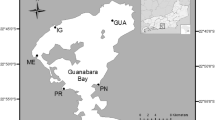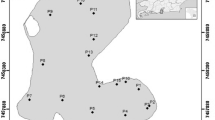Abstract
Leachate toxicity using bioindicators such as microcrustaceans and earthworms has not been fully elucidated. These bioindicators are traditionally determined through physicochemical and microbiological analyses. The ecotoxicological assessment of leachate using indicator organisms from different environments is a technique to ensure the treatment and safe disposal of this effluent with minimum impact on human health and the environment. The current study aimed to evaluate the ecotoxicological responses of Daphnia magna and Eisenia andrei in landfill leachate, identifying which organism was more sensitive to this effluent. The leachate used in ecotoxicological tests was collected at the Campina Grande Sanitary Landfill (ASCG), Paraíba, Brazil. The leachate sample contained a high content of organic matter in the form of chemical oxygen demand (19496.86 mg.L−1) and ammoniacal nitrogen (2198.00 mg.NL−1), in addition to metals with carcinogenic potential, such as Cr (0.64 mg.L−1) and Fe (1.16 mg.L−1). The exposure of Daphnia magna to the leachate showed that the effluent is harmful to aquatic organisms, obtaining an EC 50, 48 h = 1.22%, FT of 128 and a TU of 81.96%. Among the contaminant concentrations tested in Eisenia andrei, 57% (59.28 mL.kg−1) caused the highest lethality, causing the death of 21 earthworms within 72 hours of exposure. The avoidance test showed that exposure to leachate concentrations between 10.38 and 39.86 mL.kg−1 led to the leakage of earthworms, and habitat loss was observed at a concentration of 55.80 mL.kg−1, in which leak response (LR) ≥80% was obtained. This study demonstrates that the mentioned organisms are suitable for ecotoxicological tests in landfill leachate. Moreover, the microcrustacean Daphnia magna showed the most significant sensitivity, presenting a rapid ecotoxicological response to the leachate.


Similar content being viewed by others
References
ABNT, 2004. NBR 10.004-2004: Resíduos Sólidos: Classificação. Rio de Janeiro, RJ. 77
ABNT, 2014. NBR 15537: ecotoxicologia terrestre: ecotoxicidade aguda: método de ensaio para minhocas. Rio de Janeiro, RJ. 13
ABNT, 2016. NBR 12713: Ecotoxicologia aquática - Toxicidade aguda - Método de ensaio com Daphnia spp (Crustacea, Cladocera). Rio de Janeiro, RJ
ABNT, 2021. NBR 15469: Ecotoxicology - Collection, preservation and preparation of samples. Rio de Janeiro, RJ
Alimba CG, Bakare AA (2016) In vivo micronucleus test in the assessment of cytogenotoxicity of landfill leachates in three animal models from various ecological habitats. Ecotoxicology. 25:310–319
Araujo, PS, Análise do desempenho de um solo compactado utilizado na camada de cobertura de um aterro sanitário. Civil and Environmental Engineering, Vol. Master. Universidade Federal de Campina Grande, Campina Grande, 2017
Arunbabu V et al. (2017) Leachate pollution index as an effective tool in determining the phytotoxicity of municipal solid waste leachate. Waste Manag 68:329–336
Baderna D et al. (2019) Investigating landfill leachate toxicity in vitro: A review of cell models and endpoints. Environ Int 122:21–30
Baird, RB, Standard methods for the examination of water and wastewater, 23rd. Water Environment Federation, American Public Health Association, American …, 2017
Bernard C et al. (1996) Estimation of the hazard of landfills through toxicity testing of leachates-I. Determination of leachate toxicity with a battery of acute tests. Chemosphere. 11:2303–2320
Bernard F et al. (2015) Antioxidant responses of Annelids, Brassicaceae and Fabaceae to pollutants: a review. Ecotoxicol Environ Saf 114:273–303
Bove D et al. (2015) A critical review of biological processes and technologies for landfill leachate treatment. Chem Eng Technol 38:2115–2126
Brasil, 2011. Resolução n° 430, de 13 de maio de 2011. Dispõe sobre as condições e padrões de lançamento de efluentes, complementa e altera a Resolução no 357, de 17 de março de 2005, do Conselho Nacional do Meio Ambiente-CONAMA. Diário Oficial da União
Buckova M et al. (2017) Fast ecotoxicity detection using biosensors. Water Air Soil Pollut 228:166
Carabalí-Rivera Y et al. (2017) Determination of leachate toxicity through acute toxicity using Daphnia pulex and anaerobic toxicity assays. Ingeniería e Investigación 37:16–24
Clarke BO et al. (2015) Investigating landfill leachate as a source of trace organic pollutants. Chemosphere. 127:269–275
Coelho, RDS, Avaliação da toxicidade de fluidos de usinagem através da ecotoxicologia aquática. Universidade de São Paulo, 2006
Colombo A et al. (2019) Toxicity evaluation of the landfill leachate after treatment with photo-Fenton, biological and photo-Fenton followed by biological processes. J Environ Sci Health Part A 54:269–276
Costa AM et al. (2019) Landfill leachate treatment in Brazil–An overview. J Environ Manag 232:110–116
Costa, AM, et al., Avaliação da Ecotoxicidade do Lixiviado do Aterro Sanitário de Seropédica-RJ Utilizando os Organismos A. fischeri, D. similis E D. Congresso Brasileiro de Ecotoxicologia, Aracaju, SE, Brazil, 2018, pp. 718
Da Silva, LF, et al., Importância da Utilização de Bioensaios com Diferentes Níveis Tróficos para a Avaliação da Ecotoxicidade de Lixiviados de Aterros Sanitários. Congresso Brasileiro de Ecotoxicologia, Aracaju, SE, Brazil, 2018, pp. 758
Lisbôa RM et al. (2021) Ecotoxicological responses of Eisenia andrei exposed in field-contaminated soils by sanitary sewage. Ecotoxicology and Environmental Safety 214:112049
Fernandes A et al. (2019) Ecotoxicological evaluation of electrochemical oxidation for the treatment of sanitary landfill leachates. Environ Sci Pollut Res 26:24–33
Franco, HA, et al., 2016. Aplicação de lixiviado de aterro sanitário em substrato para produção de mudas florestais: uma abordagem ecotoxicológica. In IV CBRA. Congresso Brasileiro de Reflorestamento Ambiental. Proceedings. Rio de Janeiro: Reflorestamento Ambiental, pp. 113-117
Garbo F et al. (2019) Assessment of the ecotoxicity of phytotreatment substrate soil as landfill cover material for in-situ leachate management. J Environ Manag 231:289–296
Garcia, M, 2004. Effects of pesticides on soil fauna: development of ecotoxicological test methods for tropical regions. Cuvillier Verlag
Ghosh P et al. (2017) Bioassays for toxicological risk assessment of landfill leachate: A review. Ecotoxicol Environ Saf 141:259–270
Gomes BCV et al. (2016) Potencial toxicológico de metais presentes em solos de cemitérios de Santa Maria-RS. Revista Ambiente & Água 11:145–155
Guedes MJF et al. (2018) Avaliação de emissões de biogás e geração de energia em aterro sanitário no semiárido brasileiro. Revista Ibero-Americana de Ciências Ambientais 9:188–203
INSA, O semiárido Brasileiro. Vol. 2021, 2021
ISO11268-1, ISO 11268-1: soil quality–effects of pollutants on earthworms (Eisenia fetida). Part 2. Determination of Effects on Reproduction. ISO Geneva, 1997
ISO11268-3, ISO 11268-3: Soil quality — Effects of pollutants on earthworms — Part 3: Guidance on the determination of effects in field situations. ISO Geneva, 2014
ISO 17512-1, ISO 17512-1: Soil Quality - Avoidance Test for Determining the Quality of Soils and Effects of Chemicals on Behaviour Part 1: Test with Earthworms (Eisenia fetida and Eisenia andrei). ISO Geneva, 2011
Jóźwiak MA, Jóźwiak M, Kozłowski R, Żelezik M (2019) Zooremediation of leachates from municipal waste using Eisenia fetida (SAV.). Environmental Pollution 254:112871
Kjeldsen P et al. (2002) Present and long-term composition of MSW landfill leachate: a review. Crit Rev Environ Sci Technol 32:297–336
Klauck CR et al. (2017) Toxicity elimination of landfill leachate by hybrid processing of advanced oxidation process and adsorption. Environ Technol Innovat 8:246–255
Luo H et al. (2019) Review of leaching behavior of municipal solid waste incineration (MSWI) ash. Sci Total Environ 668:90–103
Luo H et al. (2020) Recent advances in municipal landfill leachate: A review focusing on its characteristics, treatment, and toxicity assessment. Sci Total Environ 703:135468
Maia IS et al. (2015) Avaliação do tratamento biológico de lixiviado de aterro sanitário em escala real na Região Sul do Brasil. Engenharia Sanitaria e Ambiental 20:665–675
Maiti SK et al. (2016) Characterization of leachate and its impact on surface and groundwater quality of a closed dumpsite–a case study at Dhapa, Kolkata, India. Procedia. Environ Sci 35:391–399
Mkhinini M et al. (2019) Effect of treated wastewater irrigation in East Central region of Tunisia (Monastir governorate) on the biochemical and transcriptomic response of earthworms Eisenia andrei. Sci Total Environ 647:1245–1255
Mukherjee S et al. (2015) Contemporary environmental issues of landfill leachate: assessment and remedies. Crit Rev Environ Sci Technol 45:472–590
OECD, 1984. 207: Earthworm, acute toxicity tests, 1984. OECD guidelines for the testing of chemicals, section. 2
Oliveira, MNPBV, 2017. Reutilização de áreas de lixões encerrados: aspectos jurídicos e ensaios ecotoxicológicos em chorume do lixão de Santa Cruz – RJ. Thesis – Civil and Environmental Department, Pontifícia Universidade Católica do Rio de Janeiro, Rio de Janeiro - RJ. 106p
Paixão Filho, J. L. d., Lixiviado de aterro sanitário: alternativas de tratamento para o cenário brasileiro. PhD dissertation. Unicamp, 2017, pp. 246
Qiu A et al. (2016) Evaluation of the treatment process of landfill leachate using the toxicity assessment method. Int J Environ Res Public Health 13:1262
Renou S et al. (2008) Landfill leachate treatment: Review and opportunity. J Hazard Mater 150:468–493
Restrepo JJB et al. (2017) Correlation between acute toxicity for Daphnia magna, Aliivibrio fischeri and physicochemical variables of the leachate produced in landfill simulator reactors. Environ Technol 38:2898–2906
Robinson T (2017) Removal of toxic metals during biological treatment of landfill leachates. Waste Manag 63:299–309
Sackey LN et al. (2020) Ecotoxicological effects on Lemna minor and Daphnia magna of leachates from differently aged landfills of Ghana. Sci Total Environ 698:134295
Saggioro EM et al. (2019) Lethal and sublethal effects of acetamiprid on Eisenia andrei: behavior, reproduction, cytotoxicity and oxidative stress. Ecotoxicol Environ Saf 183:109572
Sales Junior, SF, Avaliação ecotoxicológica de lixiviado de aterro de resíduos sólidos utilizando minhocas da espécie Eisenia andrei: estresse oxidativo, citotoxicidade e genotoxicidade. 2019
Sales Junior SF et al. (2021) Lethal and long-term effects of landfill leachate on Eisenia andrei earthworms: Behavior, reproduction and risk assessment. J Environ Manag 285:112029
Silva, EM, 2022 Ecotoxicidade de resíduos sólidos urbanos e de lixiviado gerado em aterro sanitário. PhD dissertation. Universidade Federal de Campina Grande, Campina Grande – PB, pp. 185
Singh S et al. (2016) Earthworm as ecological engineers to change the physico-chemical properties of soil: soil vs vermicast. Ecol Eng 90:1–5
Sisinno, CLS, Niemeyer, JC, Segat, JC, Oliveira Filho, LCI, Niva, CC and Brown, GG, 2019. Importância e aplicações dos ensaios ecotoxicológicos com oligoquetas. Embrapa Cerrados-Capítulo em livro científico (ALICE)
Souto G, Povinelli J (2007) Características do lixiviado de aterros sanitários no Brasil. Congresso Brasileiro de Engenharia Sanitária e Ambiental 24:2007
Uwizeyimana H et al. (2017) The eco-toxic effects of pesticide and heavy metal mixtures towards earthworms in soil. Environ Toxicol Pharmacol 55:20–29
Von Sperling, M, 2017. Lagoas de estabilização: princípios do tratamento biológico de águas residuárias. Editora UFMG
Wdowczyk A, Szymańska-Pulikowska A (2021) Analysis of the possibility of conducting a comprehensive assessment of landfill leachate contamination using physicochemical indicators and toxicity test. Ecotoxicol Environ Saf 221:112434
Yang G et al. (2018) Combined effects of four pesticides and heavy metal chromium (VI) on the earthworm using avoidance behavior as an endpoint. Ecotoxicol Environ Saf 157:191–200
Yan H et al. (2015) Perfluoroalkyl acids in municipal landfill leachates from China: Occurrence, fate during leachate treatment and potential impact on groundwater. Sci Total Environ 524:23–31
Yang H et al. (2019) Rural solid waste—characteristics and leachate pollution assessment for different precipitation levels, China. Environ Sci Pollut Res 26:11234–11244
Acknowledgements
We appreciate the financial support provided by the Higher Education Improvement Coordination (CAPES; finance code 001).
Author contributions
All authors contributed to the study conception and design. EMS: Conceptualization, Investigation, Software and Data curation, Writing. NAG: Writing, Methodology and Data curation. SCN: Writing, Methodology and Investigation. BMAN: Writing, Methodology and Reviewing. VEDM: Conceptualization, Supervision, and Validation. MCM: Supervision, Reviewing and Visualization.
Author information
Authors and Affiliations
Corresponding author
Ethics declarations
Conflict of interest
The authors declare no competing interests.
Ethical approval
All applicable international, national and/or institutional guidelines for the care and use of animals were followed.
Additional information
Publisher’s note Springer Nature remains neutral with regard to jurisdictional claims in published maps and institutional affiliations.
Supplementary Information
Rights and permissions
Springer Nature or its licensor holds exclusive rights to this article under a publishing agreement with the author(s) or other rightsholder(s); author self-archiving of the accepted manuscript version of this article is solely governed by the terms of such publishing agreement and applicable law.
About this article
Cite this article
da Silva, E.M., Gomes, N.A., do Nascimento, S.C. et al. Ecotoxicological responses of Daphnia magna and Eisenia andrei in landfill leachate. Ecotoxicology 31, 1299–1309 (2022). https://doi.org/10.1007/s10646-022-02587-7
Accepted:
Published:
Issue Date:
DOI: https://doi.org/10.1007/s10646-022-02587-7




